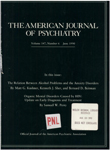Phenomenology of major depression from childhood through adulthood: analysis of three studies
Abstract
The frequency of depressive symptoms was compared in four psychiatrically referred populations: preschool (N = 9) and prepubertal (N = 95) children, adolescents (N = 92), and adults (N = 100). All had been systematically interviewed and diagnosed according to very similar criteria. Symptoms of depressed mood, diminished concentration, insomnia, and suicidal ideation occurred with similar frequencies across this developmental span. Anhedonia, diurnal variation, hopelessness, psychomotor retardation, and delusions increased with age; depressed appearance, low self-esteem, and somatic complaints decreased with age. The authors conclude that age modifies symptom frequency but does not alter basic phenomenology.
Access content
To read the fulltext, please use one of the options below to sign in or purchase access.- Personal login
- Institutional Login
- Sign in via OpenAthens
- Register for access
-
Please login/register if you wish to pair your device and check access availability.
Not a subscriber?
PsychiatryOnline subscription options offer access to the DSM-5 library, books, journals, CME, and patient resources. This all-in-one virtual library provides psychiatrists and mental health professionals with key resources for diagnosis, treatment, research, and professional development.
Need more help? PsychiatryOnline Customer Service may be reached by emailing [email protected] or by calling 800-368-5777 (in the U.S.) or 703-907-7322 (outside the U.S.).



